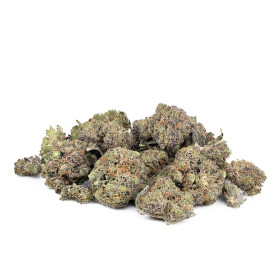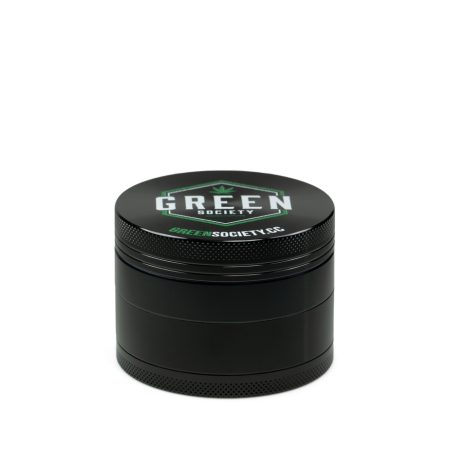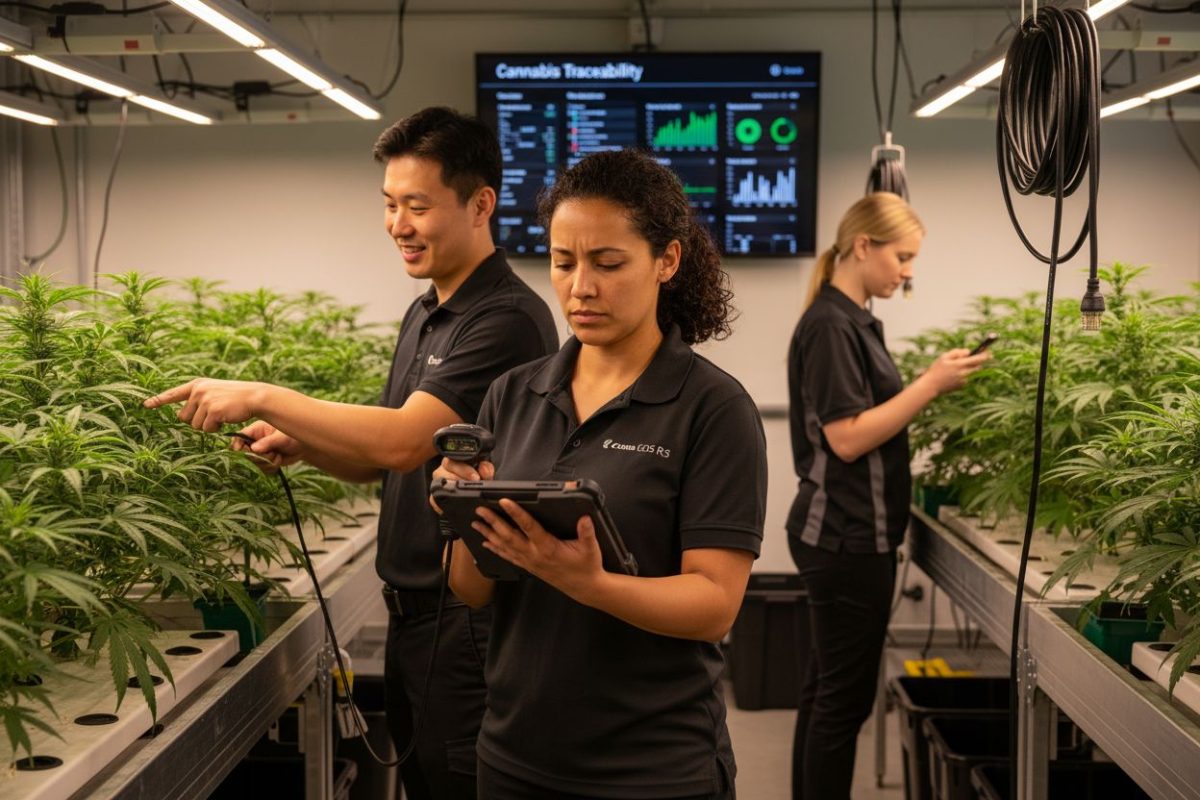Marijuana
Understanding What is Cannabis Traceability and Why It Matters
Cannabis traceability seems like a technical detail only producers worry about, but it actually shapes the safety of products on every store shelf. Surprisingly, every legal cannabis product in Canada carries a digital record tracing its journey from seed to sale. Most buyers do not realize that this tracking power can identify issues within hours, keeping unsafe products out of your hands before you ever walk through the dispensary door.
Table of Contents
- Defining Cannabis Traceability: Key Concepts To Know
- The Importance Of Cannabis Traceability In The Market
- How Cannabis Traceability Works: The Process Explained
- Regulatory Frameworks Surrounding Cannabis Traceability
- Real-World Impact Of Cannabis Traceability On Consumers
Quick Summary
| Takeaway | Explanation |
|---|---|
| Cannabis traceability ensures product safety | Tracking systems help identify contaminated products and verify cannabis origin to protect consumers. |
| Robust documentation protects consumer interests | Detailed records promote transparency and accountability in the cannabis supply chain, boosting consumer confidence. |
| Traceability supports regulatory compliance | Government agencies rely on tracking systems to enforce regulations and monitor legal product distribution, preventing illicit market activities. |
| Advanced technology enhances tracking systems | Utilizing tools like RFID and blockchain improves real-time product monitoring and documentation throughout the supply chain. |
| Consumer empowerment through detailed information | Traceability allows consumers to access crucial details about product quality, cultivation practices, and safety standards. |
Defining Cannabis Traceability: Key Concepts to Know
Cannabis traceability represents a comprehensive tracking system designed to monitor cannabis products from seed to sale. This sophisticated process ensures transparency, safety, and accountability throughout the entire production and distribution lifecycle. Research from the National Center for Biotechnology Information highlights the critical role of traceability in maintaining product integrity and consumer protection.
The Fundamental Framework of Cannabis Tracking
At its core, cannabis traceability involves creating a detailed digital record of each product’s journey. This means capturing and documenting critical information at every stage:
- Origin of the cannabis plant
- Cultivation conditions and methods
- Processing techniques
- Transportation details
- Distribution channels
- Final retail destination
These comprehensive records allow regulators, producers, and consumers to understand exactly where a cannabis product originated and how it reached its current point in the supply chain. By maintaining meticulous documentation, the industry can quickly address potential quality concerns, track potential contamination sources, and verify product authenticity.
Why Traceability Matters in Cannabis Regulation
Traceability serves multiple critical functions beyond simple record-keeping. It acts as a fundamental mechanism for ensuring consumer safety, regulatory compliance, and industry standardization. Government agencies and licensed producers use these tracking systems to monitor product movement, prevent diversion into illegal markets, and maintain strict quality control standards.
For consumers interested in understanding more about product verification, our guide on reading product labels offers additional insights into interpreting cannabis product information.
By implementing robust traceability protocols, the cannabis industry demonstrates its commitment to transparency, safety, and responsible production. These systems protect consumers, support legal compliance, and build trust in a rapidly evolving market landscape.
The Importance of Cannabis Traceability in the Market
Cannabis traceability has become a cornerstone of modern cannabis market regulation, transforming how products are monitored, distributed, and consumed. Research from PubMed demonstrates that robust traceability systems are critical for ensuring consumer safety and industry accountability.
Consumer Protection and Product Safety
Traceability serves as a fundamental safeguard for cannabis consumers. By meticulously documenting each product’s journey, the industry can:
- Quickly identify and remove potentially contaminated products
- Verify the authenticity of cannabis origin
- Ensure compliance with quality and safety standards
- Provide transparent information about product composition
- Track potential health risks associated with specific batches
These comprehensive tracking mechanisms protect consumers from potential health risks and provide unprecedented transparency in product sourcing. Detailed documentation allows for immediate intervention if any safety concerns emerge, creating a proactive approach to consumer protection.
Economic and Regulatory Implications
Beyond consumer safety, traceability plays a crucial role in the economic and regulatory landscape of the cannabis industry. Government agencies and licensed producers rely on these systems to:
- Monitor product distribution channels
- Prevent illegal market diversion
- Enforce tax collection and regulatory compliance
- Support legitimate cannabis businesses
- Create a transparent and accountable supply chain
Our guide on understanding product quality provides additional context on how traceability contributes to overall product excellence.
The implementation of comprehensive traceability systems represents a significant evolution in cannabis market regulation. By creating transparent, accountable, and verifiable product tracking, the industry demonstrates its commitment to responsible production, consumer safety, and long-term market sustainability.
The table below compares how cannabis traceability benefits both consumers and the industry by organizing key impacts already covered in the article.
| Stakeholder | Key Benefits of Traceability | Examples from Article |
|---|---|---|
| Consumers | Enhanced safety and product confidence | Quick recalls, verification of authenticity |
| Access to detailed product information | Cultivation practices, cannabinoid profiles | |
| Protection from contaminated or counterfeit products | Transparent records, instant batch identification | |
| Cannabis Industry | Improved regulatory compliance and accountability | Monitoring market diversion, detailed documentation |
| Economic advantage through support of legitimate business | Enforcement of tax collection, business transparency | |
| Streamlined quality control and supply chain transparency | Supply chain monitoring, quick response to issues |
How Cannabis Traceability Works: The Process Explained
Cannabis traceability is a sophisticated digital tracking system that monitors each cannabis product from its initial cultivation to final consumer sale. According to the CDC, each product batch receives a unique identifier that enables comprehensive tracking throughout its entire lifecycle.
Digital Tracking and Identification Systems
The traceability process relies on advanced technological infrastructure that captures critical data points. Key tracking components include:
- Unique batch and lot numbers
- Precise geographical origin details
- Cultivation and processing timestamps
- Genetic strain information
- Detailed transportation records
- Quality control test results
These digital records create an unbroken chain of documentation, allowing regulators and producers to instantaneously verify a product’s complete history.
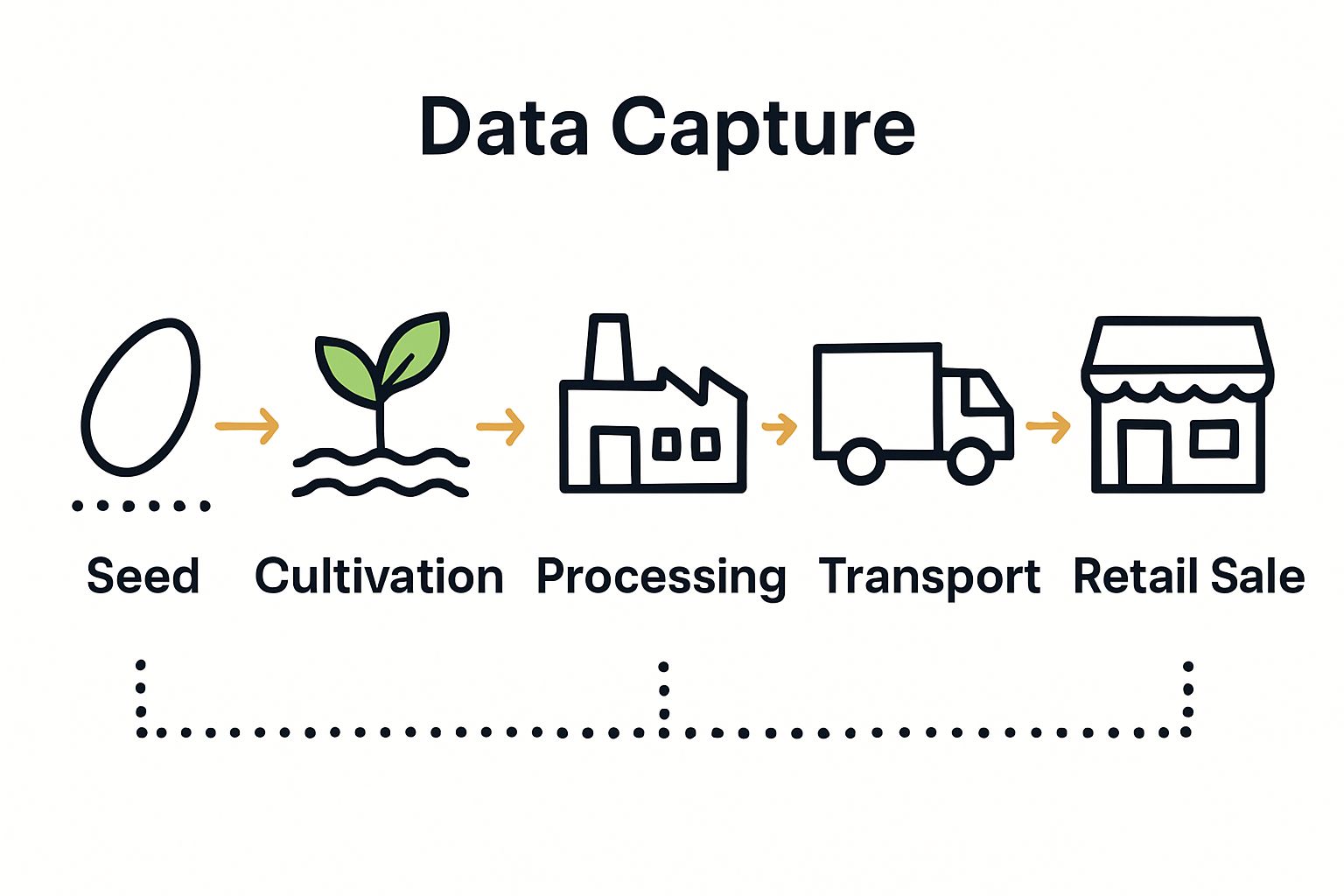
Digital tracking platforms utilize specialized software that records every transaction, movement, and transformation of cannabis products.
Technological Infrastructure and Documentation
Modern traceability systems integrate multiple technological tools to ensure comprehensive monitoring:
- Radio-frequency identification (RFID) tags
- Blockchain-based tracking platforms
- Comprehensive inventory management software
- Secure cloud-based documentation systems
- Advanced data encryption technologies
Our guide on understanding legal cannabis online purchases provides additional context about how these tracking systems support responsible cannabis distribution.
The integration of these advanced tracking mechanisms transforms cannabis production from an opaque process to a transparent, accountable industry standard.
Here is a summary table outlining the main technological features used in modern cannabis traceability systems and their key functions within the Canadian market.
| Technology/Feature | Purpose in Cannabis Traceability | Example Functionality |
|---|---|---|
| RFID Tags | Unique identification and tracking | Real-time product location monitoring |
| Blockchain Tracking Platforms | Secure, immutable tracking records | Prevents data tampering, provides transparency |
| Inventory Management Software | Centralizes and automates records | Streamlines compliance and batch reporting |
| Cloud-based Documentation | Secure, remote access to data | Enables multi-party access to traceability info |
| Data Encryption Technologies | Protects data integrity and privacy | Prevents unauthorized access to tracking data |
Regulatory Frameworks Surrounding Cannabis Traceability
Regulatory frameworks for cannabis traceability represent complex legal mechanisms designed to ensure comprehensive oversight of cannabis production, distribution, and consumption. According to Health Canada, these frameworks establish stringent guidelines that mandate precise documentation and monitoring throughout the cannabis supply chain.
National and Provincial Regulatory Standards
Cannabis traceability regulations typically encompass multiple layers of governance, creating a robust system of accountability. Key regulatory priorities include:
- Establishing clear licensing requirements
- Mandating comprehensive record-keeping
- Implementing strict product testing protocols
- Ensuring transparent reporting mechanisms
- Creating standardized tracking documentation
- Preventing unauthorized product distribution
These standards function as a comprehensive framework that transforms cannabis production from an informal industry into a highly regulated, professionally managed sector. Government agencies collaborate with licensed producers to develop and enforce these intricate regulatory standards.
Technological Compliance and Reporting
Modern cannabis traceability regulations require sophisticated technological infrastructure to support comprehensive monitoring:
- Real-time digital tracking systems
- Secure data transmission protocols
Our guide on marijuana legalization in Canada provides additional context about the evolving regulatory landscape.
By implementing these rigorous frameworks, regulatory bodies create a transparent ecosystem that protects consumer interests, supports legal market development, and establishes clear accountability mechanisms for cannabis production and distribution. The ongoing refinement of these regulatory standards demonstrates a commitment to responsible cannabis market management.
Real-World Impact of Cannabis Traceability on Consumers
Cannabis traceability directly transforms consumer experience by providing unprecedented transparency and safety in product selection. Research from the National Institutes of Health demonstrates how tracking mechanisms empower consumers with critical product information that was previously unavailable.
Enhanced Consumer Safety and Confidence
Traceability systems fundamentally reshape consumer interactions with cannabis products by offering comprehensive protection and information:
- Instant verification of product authenticity
- Detailed information about cultivation practices
- Precise cannabinoid and terpene profiles
- Clear documentation of potential contaminants
- Complete record of product transportation and storage
- Verification of legal sourcing and compliance
These detailed tracking mechanisms eliminate uncertainty, allowing consumers to make informed decisions based on verifiable data.
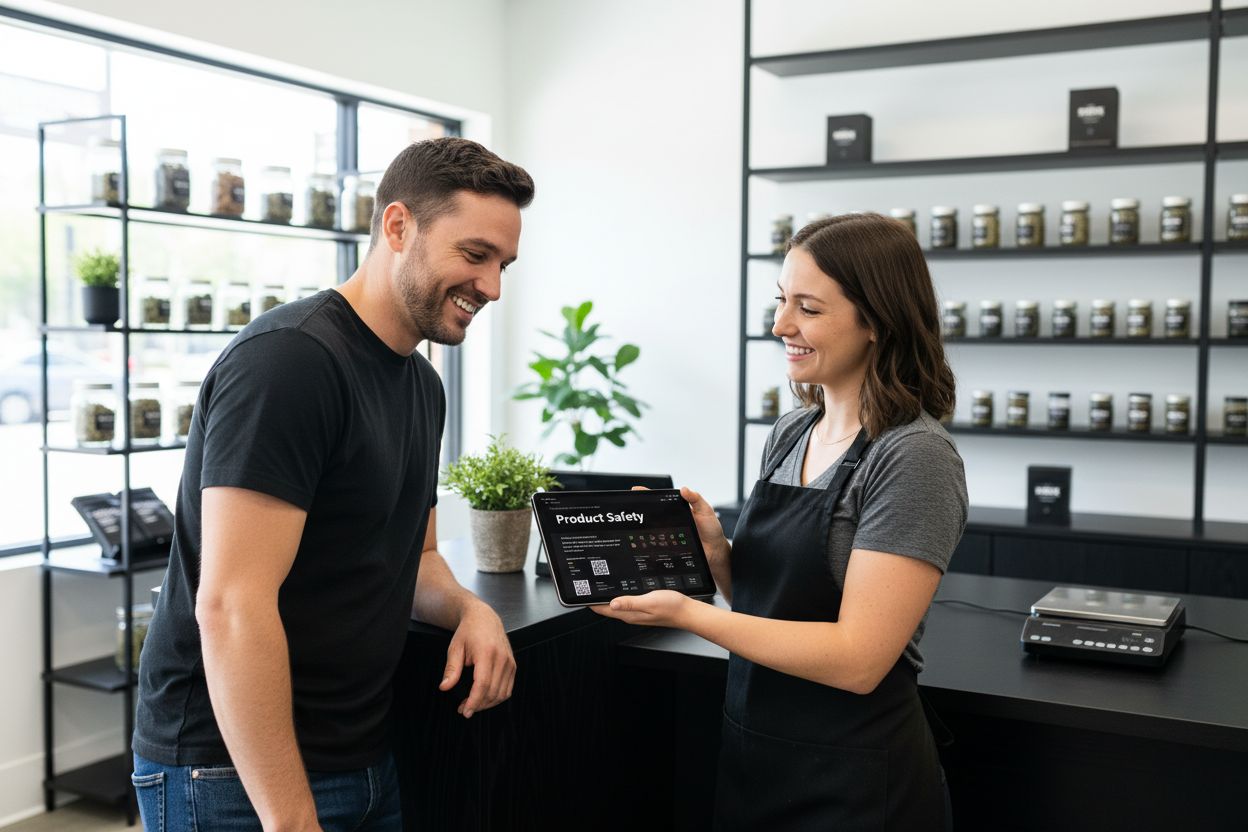 By understanding exactly where their cannabis originates, consumers gain unprecedented insight into product quality and safety standards.
By understanding exactly where their cannabis originates, consumers gain unprecedented insight into product quality and safety standards.
Health and Quality Assurance Benefits
The real-world implications of robust traceability extend far beyond simple record-keeping. Consumers benefit from:
- Rapid identification of potential health risks
- Quick product recall mechanisms
- Transparent quality control processes
- Ability to research specific product histories
- Protection against counterfeit or adulterated products
Our guide on third-party testing provides additional context about how traceability supports product quality verification.
Ultimately, cannabis traceability transforms consumer experiences by creating a transparent, accountable ecosystem that prioritizes safety, quality, and informed choice. As the cannabis industry continues to evolve, these tracking mechanisms will become increasingly sophisticated, further empowering consumers with knowledge and confidence.
Experience True Cannabis Confidence With Green Society
Worried about where your cannabis comes from or if it meets strict quality standards? If you found the journey from seed to sale fascinating, you know how much cannabis traceability matters for your safety and satisfaction. Green Society is dedicated to transparent, accountable sourcing. We understand your concerns about product authenticity, labelling, and responsible distribution. That is why our curated selection includes detailed product tracking and third-party testing information for every item you buy.

Stop guessing about product quality and enjoy your cannabis with peace of mind. Visit Green Society today for a wide range of flowers, edibles, and more. Dive deeper with our guide to reading product labels or discover why third-party testing matters before your next purchase. Shop now and experience fast, discreet delivery backed by transparency you can trust.
Frequently Asked Questions
What is cannabis traceability?
Cannabis traceability is a system that tracks cannabis products from seed to sale, ensuring transparency and safety throughout the entire production and distribution process. To understand how it works, focus on key stages like cultivation, processing, and transportation, enabling you to follow a product’s journey from origin to retail.
Why is cannabis traceability important for consumer safety?
Cannabis traceability helps protect consumers by allowing for the quick identification of contaminated products and verifying product authenticity. To enhance your safety, always look for products with clear traceability information, which ensures compliance with quality standards and promotes informed choices.
How can I verify the traceability of a cannabis product?
You can verify the traceability of a cannabis product by checking for unique identifiers like batch numbers and detailed product labels. Research the product’s origins and processing details to ensure it meets safety and quality expectations.
What role do regulators play in cannabis traceability?
Regulators enforce cannabis traceability standards to maintain industry accountability and ensure compliance with legal requirements. To stay compliant, make sure your business adheres to the established guidelines for record-keeping and monitoring across the supply chain.
How can cannabis traceability affect product recalls?
In the event of a safety issue, cannabis traceability enables rapid identification and removal of affected products from the market. For efficient responses, familiarize yourself with the recall procedures that leverage traceability systems to protect consumer health swiftly.
What technologies support cannabis traceability?
Technologies like RFID tags and blockchain systems facilitate comprehensive tracking of cannabis products throughout their lifecycle. To utilize these technologies effectively, integrate secure digital systems that record every transaction and movement of products.
Recommended
- Understanding Why Third-Party Testing Matters for Cannabis ~ Green Society Blog
- How to Read Product Labels: Navigate Cannabis Choices Wisely ~ Green Society Blog
- Understanding Why Product Quality Matters for Cannabis ~ Green Society Blog
- Understanding Legal Cannabis Online Purchases ~ Green Society Blog




